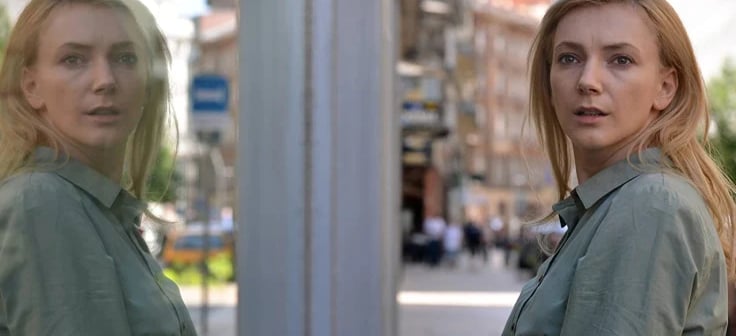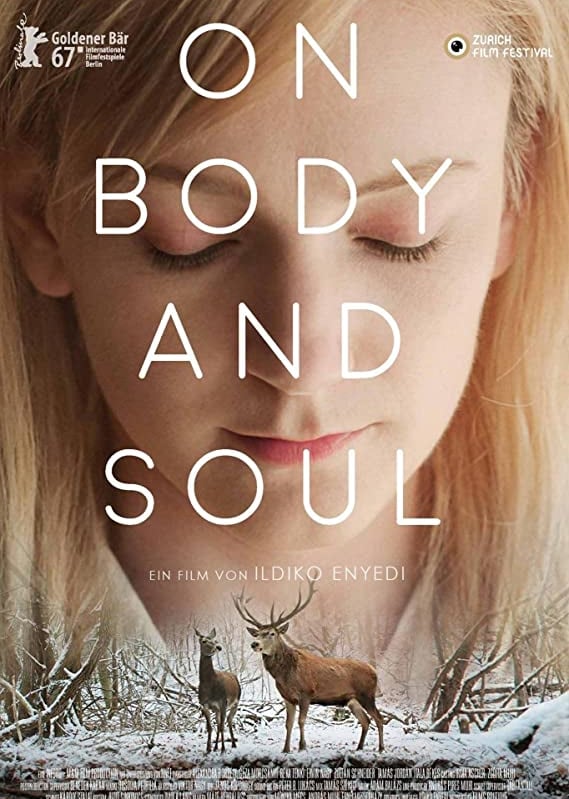On Body and Soul
A surreal, intimate love story that blooms through shared dreams and the tender ache of two lonely souls.
A Dreamlike Encounter Between Two Unlikely Hearts
On Body and Soul opens in the quiet antiseptic corridors of a Budapest slaughterhouse, where Mária, a socially awkward and rule-bound meat inspector, and Endre, the restrained CFO with a paralyzed arm, inhabit separate routines until an uncanny secret draws them together: they share the same dream each night. This slow-burning revelation unfolds with haunting subtlety, reframing their stifled daytime lives through a shared subconscious realm. In dreams, they move freely through snow-dusted woods, their disembodied selves mirroring the leap of a stag and doe grazing alone beneath winter branches. These deer stand in stark contrast to the slaughterhouse’s brutality—a poetic metaphor for fragile intimacy emerging amid physical detachment and emotional isolation. Mária’s restraint and Endre’s hidden tenderness meet in the dreamscape of trust before ever meeting in reality. Audiences are drawn deeply into a story rooted in longing, awkwardness, and the hope of connection beneath the skin, guided by a narrative sensitive to gestures, silences, and the emotional weight found in shared nightly communion.
A Delicate Balance of Realism and Magical Realism
Director Ildikó Enyedi crafts On Body and Soul with an unusual marriage of austere realism and magical whimsy. The slaughterhouse scenes are rendered with clinical precision—cold steel, rigorous protocols, and the muted rhythm of workers moving through carcasses. Yet into that world she introduces the surreal dream dimension: two deer wandering alone, breathing in tandem, walking side by side under falling snow. These interludes are not cinematic excess; they feel necessary, as though Mária and Endre carry an unseen emotional life sealed within them. The film refrains from explaining their connection with dialogue. Instead, it trusts in symbol and minimalism, merging two genres into one coherent emotional experience. The deer become agents of psychic contact, enabling intimacy without words, and underscoring how personal connection often begins quietly, invisibly. It is this thoughtful overlay of hidden landscapes onto everyday routine that gives the film both intellectual depth and emotional resonance.
Critical Acclaim and Cinematic Honors
On Body and Soul debuted at the 67th Berlin International Film Festival, where it won the prestigious Golden Bear, the FIPRESCI Prize, and the Ecumenical Jury Award. It carried the Berlin spotlight as the festival closer, underlining its universal appeal blended with Hungarian particularity. Selected as Hungary’s entry for Best Foreign Language Film, it earned an Oscar nomination and secured a 90% Rotten Tomatoes rating with critics lauding it as "an eccentric, dreamy portrait of love and loneliness". On Metacritic it holds a 77/100; review platforms praised Director Enyedi for her bold emotional language and thematic restraint. It was also nominated for several European Film Awards, with Borbély winning Best Actress and the film itself receiving recognition for cinematography and screenplay. Reviews describe it as both "intellectually daring and emotionally rewarding" and “a small story with profound depth”
Where and How to Watch
For those wanting to experience On Body and Soul, it is widely accessible via major streaming platforms. In many regions it is currently available on Netflix—including the standard ad-supported tier—with subtitles in multiple languages. The film is also offered to rent or purchase on platforms like Apple TV, Amazon Video, and Plex, often with HD quality and original Hungarian audio tracks. Select arthouse services such as MUBI intermittently host it, though availability may vary or require subscription. Physical editions—Blu-ray or DVD—are available for collectors or archival quality viewing, often containing behind‑the‑scenes interviews and director commentary. Before watching, viewers should be aware that the film uses minimal visual explicitness in the slaughterhouse scenes, opting for symbolic representation rather than graphic realism. Parental discretion is advised due to emotional complexity and occasional violence-themed context.


Cinematic Craft: Visual Poetry and Sound as Emotional Undertone
Every frame of On Body and Soul feels composed with painterly attention—in wide aspect ratio, with muted palettes and precise framing. Cinematographer Máté Herbai transforms ordinary spaces into prayerful stages, using soft light to capture vapour drifting in refrigerated rooms or the delicate shimmer of frost on deer fur. The slaughterhouse appears stark and condemned, but also strangely ordered—a space where control unravels in the tenderness of dreams. Composer Ádám Balázs uses ambient sound sparingly; the crunch of footsteps across ice, the hum of refrigeration, or rustle of a dream leaves feel like profound resonances. When music appears—in a whispered song shared between characters—it becomes itself a language of longing. The quietness of dialogue, combined with soundscape precision, sustains a tension between internal life and outward silence, echoing the characters’ gradual, careful learning to inhabit realms of emotion they never expected to share.
A Study of Introversion, Empathy, and Emotional Reawakening
Alexandra Borbély and Géza Morcsányi merge inextricably with their characters—Borbély crafting a Mária raw with asymmetrical social isolation and sparse trust, and Morcsányi offering Endre’s dry humor and wounded longing in equal measure. Their performances are exercises in quiet intensity: small smiles, hesitant touches, a long lingering gaze across the lunchroom. Critics praised their emotional truth and psychological subtlety, with Borbély winning European Film Award for Best Actress. The film allows their slow crossing toward one another: first through visible empathy, then through shared decisions like sleeping in the same room to sustain nightly dreams. As one critic put it, the film builds steadily toward a final fade to white—an uncertain frontier where dreams end but connection begins—offering an emotional reincarnation of intimacy through mutual vulnerability.






Awarded with the Highest Distinction
On Body and Soul earned the Grand Distinction for its singular blend of poetic filmmaking, psychological intimacy, cultural specificity, and cinematic boldness. It is worth watching not just for its surreal beauty or awards pedigree, but for its quiet power in depicting how love blossoms not in grand gestures but across shared vulnerability. In its dream-laced coldness and tenderness, the film reveals that true connection often begins inside silence—and that is a story worth inviting into your mind and heart.







